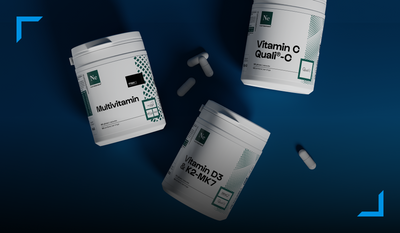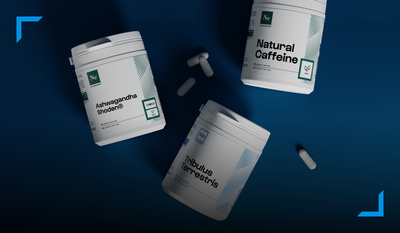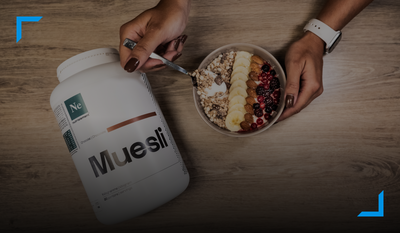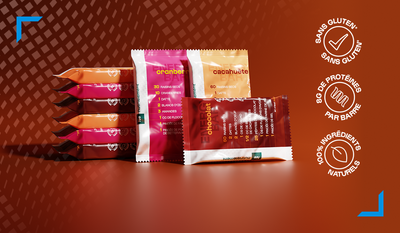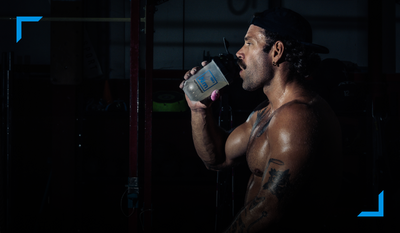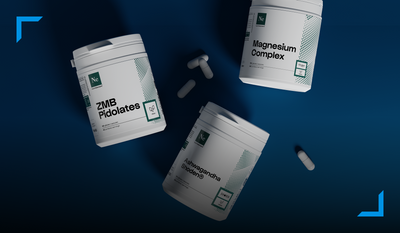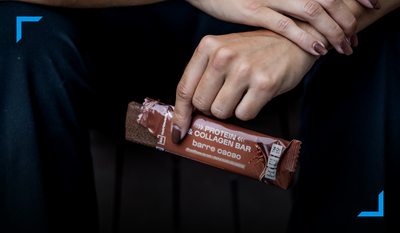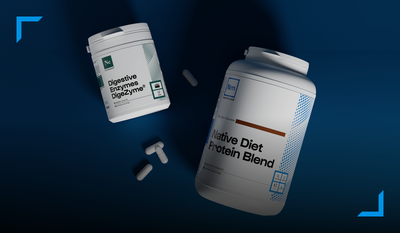0 commentaires
Is it necessary to supplement with vitamins and omega 3? What is a multivitamin supplement for? We also discuss with you the deficiencies as well as the hormonal impact of vitamins.
Omega 3
Omega 3 essential fatty acids
Omega 3 essential fatty acids are lipids mainly derived from fish fats. As with vitamins, there are omega 3 deficiencies among the French, due to the reduction in fish consumption (especially oily fish: salmon, tuna, sardines, etc.) (39).
There are two classes of omega 3 supplements:
- Those aggregated to an ethyl ester .
- Those combined as triglycerides
It is in this latter form that the best absorption of omega 3 (40-41-42) takes place.
Nutrimuscle omega 3s are found in natural form, that is to say linked to triglycerides, and not in the form of ethyl esters, even if this increases the price of the supplement.
Omega 3 has many benefits :
- Improvement of cardiovascular functions ;
- Reinforcement of the frame ;
- Protection of nerve cells by preventing neuroinflammation;
- Fight against depression (the prevalence of which increases in winter);
- Appetite regulation (increase in the satiety hormone, leptin);
- Anti-catabolic and anabolic role (43-44);
- Joint protection;
- Improved thermoregulation (to better combat the winter cold).
Freshness and quality of omega 3
It is very important to consume fresh omega 3. Indeed, the higher the oxidation, the more the health benefits of omega 3 tend to disappear and can become negative.
At Nutrimuscle, we choose to guarantee high quality and ultra-fresh raw materials , which we display thanks to the TOTOX index (the oxidation index) visible in our certificates of analysis .
Unfortunately, not all omega 3 sellers clearly mention this index. This is because the results in terms of quality are poor, even very poor. Independent studies conducted in various countries reveal that 11 to 62% of the omega 3 in supplements are oxidized (which gives a very poor TOTOX ).
Be careful, not all omega 3s are equal. Depending on their freshness, but also their origin (fish, oil, algae), they can potentially be contaminated and not have the desired effects . The importance of the freshness of omega 3s.
Hormonal impact of vitamins
Cortisol is a hormone that accelerates protein catabolism and has an anti-anabolic action. It also causes testosterone levels to drop .
The more intensely we train, the higher our cortisol levels will rise . It is therefore important for an athlete to combat the rise in this hormone . Taking vitamin C before a race reduces the rise in cortisol during exercise by 30% (35).
Taking vitamin D is associated with an increase in testosterone secretion and a decrease in myostatin secretion (a hormone that prevents muscle gain), and helps to attenuate the drop in strength between sets and reduce the feeling of fatigue that follows the session (36-37-38).
Vitamins and Omega 3 during winter
Vitamins are more effective when taken together, rather than separately , hence the interest in the Nutrimuscle Multivitamin complex, which contains vitamin A, several B vitamins, as well as vitamins C, D, E and K.
There is a health synergy in combining the regular use of vitamins with that of Omega 3. This is what medical research has shown, particularly with regard to the prevention of heart disease (45), sarcopenia and functional disorders .
Such synergy is also noted in athletes with regard to the fight against the harmful effects of free radicals (46).
Which vitamin to take with omega 3?
In addition to omega-3, vitamin D is often recommended because they work together to support bone, cardiovascular and immune health.
Vitamin D helps absorb and use calcium, contributing to bone health. Omega-3s, meanwhile, play a crucial role in reducing inflammation and promoting healthy heart function.
By taking these two supplements together, you can optimize their benefits for your overall health.
Omega 3 - Vitamin D Association
Taking omega 3 and vitamin D at the same time is beneficial for health.
Omega-3s, found particularly in oily fish such as salmon and fish oil supplements, are known for their anti-inflammatory effects and their contribution to cardiovascular health.
On the other hand, vitamin D , often called the "sunshine vitamin," is essential for bone health, immunity, and many other physiological processes.
Together, these two nutrients can boost bone and heart health, support the immune system, and help reduce inflammation in the body, so it's common to take them together to maximize their benefits.
Why a multivitamin supplement?
Vitamins are divided into 2 groups.
1- Fat-soluble vitamins (which mix with fats)
- Vitamin A helps maintain good vision and good bones, and helps keep our skin healthy and protected (the sun's UV rays attack our skin in winter too). It also protects against metabolic stress in athletes (1-2-3).
- Vitamin D contributes to the proper use of calcium and magnesium , particularly for the maintenance of bone integrity . It also allows an increase in testosterone levels and strength (4) in athletes. It also plays a role in the immune system.
- Vitamin E and tocotrienols are antioxidants . They are incorporated into the protective membrane of our cells to combat the harmful effects of free radicals, which allows them to fight against muscle catabolism . They also intervene in the oxygenation of cells, produce a diuretic action, fight against cardiovascular diseases, brain degeneration , cancers ... (5-6-7 (8-9-10) (11-12-13-14).
- Vitamin K plays a very important role in cardiovascular health, ensures the maintenance of bone strength and prevents degenerative diseases (15-16-17) (18) (19-20).
2- Water-soluble vitamins (which mix with water)
B vitamins promote the assimilation of proteins and amino acids. They participate in muscle anabolism and contribute to the production of red blood cells. During exercise, they stimulate the secretion of growth hormone. B vitamins reduce the frequency , duration and intensity of cramps (21).
- Vitamin B6: It plays a crucial role in the synthesis of certain antibodies , hemoglobin (which carries oxygen in the blood) and certain neurotransmitters such as serotonin, melatonin and dopamine.
- Vitamin B9: it helps reduce the risks of dementia , cardiovascular diseases, certain cancers and cell regeneration (muscle and nerve recovery in athletes). (22-23-24).
- Vitamin B12 : it is involved in the synthesis of DNA, proteins, myelin (a substance that forms a sheath around certain nerve fibers), in the formation of red blood cells, as well as in the metabolism of carbohydrates and lipids . Since this vitamin is only found in foods of animal origin , supplementation is interesting for people following a vegan or vegetarian diet.
- Vitamin C : It helps fight stress , accelerates cellular recovery in the event of damage and plays a crucial role in the immune system (25). It is a powerful antioxidant, useful before exercise.
There is a common feature of some vitamins in these two groups: their antioxidant capacity, that is, their ability to fight free radicals. These are vitamins E and C , tocotrienols and vitamin A. (26-27-28).
The antioxidant role
The oxygen we breathe generates free radicals , molecules that are missing an electron. These will attack all our cells, whatever they are, in order to steal this missing electron , which causes them to be damaged.
Antioxidant vitamins serve as protective shields for muscles and can help cope with work overload by fighting catabolism , fatigue and overtraining .
Deficiencies
A significant portion of the population has difficulty meeting their minimum vitamin requirements (29).
If sedentary people are in constant deficit, given that regular sports practice increases micro-nutritional losses, vitamin needs are even more problematic to satisfy in athletes ; hence the interest in vitamin supplementation. (30-31-32-33-34).
Scientific references
(1) Henning P. Retinoid receptors in bone and their role in bone remodeling. Front Endocrinol (Lausanne). 2015 Mar 11;6:31.
(2) Sorg O. Topical retinoids in skin aging: a focused update with reference to sun-induced epidermal vitamin A deficiency. Dermatology. 2014;228(4):314-25.
(3) Żychowska M. Vitamin C, A and E supplementation decreases the expression of HSPA1A and HSPB1 genes in the leukocytes of young polish figure skaters during a 10-day training camp. J Int Soc Sports Nutr. 2015 Feb 11;12:9.
(4) Hodgson AB. The Effects of 4 Weeks Vitamin D3 Supplementation on Athletic Performance Medicine & Science in Sports & Exercise. 2012 44(5S): 950
(5) Vasanthi HR.Tocotrienols and its role in cardiovascular health--a lead for drug design. Curr Pharm Des. 2011;17(21):2170-5.
(6) Prasad K. Tocotrienols and cardiovascular health. Curr Pharm Des. 2011;17(21):2147-54.
(7) Bardhan J. The 21st century form of vitamin E--tocotrienol. Curr Pharm Des. 2011;17(21):2196-205.
(8) Weng-Yew W. Nutrapharmacology of tocotrienols for metabolic syndrome. Curr Pharm Des. 2011;17(21):2206-14.
(9) Catalgol B. Cellular protection and therapeutic potential of tocotrienols. Curr Pharm Des. 2011;17(21):2215-20.
(10) Sen CK. Palm oil-derived natural vitamin E alpha-tocotrienol in brain health and disease. J Am Coll Nutr. 2010 Jun;29(3 Suppl):314S-323S.
(11) Sylvester PW. Tocotrienol combination therapy results in synergistic anticancer response. Front Biosci. 2011 Jun 1;16:3183-95. Nesaretnam K. Tocotrienols: inflammation and cancer. Ann NY Acad Sci. 2011 Jul;1229:18-22.
(12) Sylvester PW. The value of tocotrienols in the prevention and treatment of cancer. J Am Coll Nutr. 2010 Jun;29(3 Suppl):324S-333S.
(13) Ling MT. Tocotrienol as a potential anticancer agent. Carcinogenesis. 2012 Feb;33(2):233-9.
(14) Aggarwal BB. Tocotrienols, the vitamin E of the 21st century: its potential against cancer and other chronic diseases.Biochem Pharmacol. 2010 Dec 1;80(11):1613-31.
(15) Ferland G. The discovery of vitamin K and its clinical applications. Ann Nutr Metab. 2012;61(3):213-8.
(16) Theuwissen E. The role of vitamin K in soft-tissue calcification. Adv Nutr. 2012 Mar 1;3(2):166-73.
(17) Shea MK. Vitamin K status and vascular calcification: evidence from observational and clinical studies. Adv Nutr. 2012 Mar 1;3(2):158-65.
(18) Falcone TD. Vitamin K: fracture prevention and beyond. PM R. 2011 Jun;3(6 Suppl 1):S82-7.
(19) Ferland G. Vitamin K and the nervous system: an overview of its actions. Adv Nutr. 2012 Mar 1;3(2):204-12.
(20) Vermeer C. Vitamin K, osteoporosis and degenerative diseases of aging. Menopause Int. 2011 Mar;17(1):19-23.
(21) Chan-P. Randomized, double-blind, placebo-controlled study of the safety and efficacy of vitamin B complex in the treatment of nocturnal leg cramps in elderly patients with hypertension. J Clin Pharmacol. 1998. 38: p. 1151.
(22) Leemans L. [Does 5-methyltetrahydrofolate offer any advantage over folic acid?]. J Pharm Belg. 2012 Dec;(4):16-22.
(23) Araújo JR. Folates and aging: Role in mild cognitive impairment, dementia and depression. Aging Res Rev. 2015 May 2;22:9-19.
(24) Molina-López J. Effect of folic acid supplementation on homocysteine concentration and association with training in handball players. J Int Soc Sports Nutr. 2013 Feb 21;10(1):10
(25) Sasazuki S. Effect of vitamin C on common cold: randomized controlled trial. Eur J Clin Nutr. 2006 Jan;60(1):9-17').
(26) Tauler P. Diet supplementation with vitamin E, vitamin C and beta-carotene cocktail enhances basal neutrophil antioxidant enzymes in athletes. Pflugers Arch. 2002 Mar;443(5-6):791-7.
(27) Sen CK. Antioxidants in exercise nutrition. Sports Med. 2001;31(13):891-908.
(28) Sureda A.Vitamins C and E diet Supplementation Prevents Neutrophil Protein Oxidation without Affecting the Adaptive Response to Exercise. International Journal of Sport Nutrition and Exercise Metabolism 2012 Aug 14; [Epub ahead of print]
(29) Pilorin T. Consumption of food supplements in France: consumer profile and contribution to nutritional balance. Cahiers de Nutrition et de Diététique Volume 47, Issue 3, June 2012, Pages 147–155
(30) Zimmermann MB. Vitamin ans mineral supplementation and exercise performance. Schweizerische zeitschrift fûr sportmedicine and sporttraumatology. 2003. 51 (1), 53-57
(31) FINAUD J. Results of a dietary survey carried out among high-level French rugby players. Nutrition and dietetics notebooks. 2003, vol. 38, no. 4, pp. 234-241
(32) Groussard C. Evaluation of antioxidant vitamin intake in athletes. Sci. Sports, 19 (2004), pp. 193–195
(33) Machefer G. Intake and status of antioxidant vitamins in endurance athletes. Science & Sports Volume 21, Issue 2, April 2006, Pages 107–109
(34) Sato A. Dietary thiamin and riboflavin intake and blood thiamin and riboflavin concentrations in college swimmers undergoing intensive training.Int J Sport Nutr Exerc Metab. 2011 Jun;21(3):195-20
(35) Peters EM. Attenuation of increase in circulating cortisol and enhancement of the acute phase protein response in vitamin C-supplemented ultramarathoners. Int J Sports Med. 2001 Feb;22(2):120-6.
(36) Pilz S. Effect of vitamin D supplementation on testosterone levels in men. Horm Metab Res. 2011 Mar;43(3):223-5.
(37) Nimptsch K. Association between plasma 25-OH vitamin D and testosterone levels in men. Clin Endocrinol (Oxf). 2012 Jul;77(1):106-12.
(38) Garcia LA. 1,25(OH)2Vitamin D3 Stimulates Myogenic Differentiation by Inhibiting Cell Proliferation and Modulating the Expression of Promyogenic Growth Factors and Myostatin in C2C12 Skeletal Muscle Cells. Endocrinology August 1, 2011 vol. 152 no. 8 2976-2986
(39) Astorg P, et al. Dietary intakes and food sources of n-6 and n-3 PUFA in French adult men and women. Lipids. 2004 Jun;39(6):527-35.
(40) Lawson LD. Absorption of eicosapentaenoic acid and docosahexaenoic acid from fish oil triacylglycerols or fish oil ethyl esters co-ingested with a high-fat meal. Biochem Biophys Res Commun. 1988 Oct 31;156(2):960-3.
(41) Beckermann B. [Comparative bioavailability of eicosapentaenoic acid and docasahexaenoic acid from triglycerides, free fatty acids and ethyl esters in volunteers] Arzneimittelforschung. 1990 Jun;40(6):700-4.
(42) Dyerberg J. Bioavailability of marine n-3 fatty acid formulations. Prostaglandins Leukot Essent Fatty Acids. 2010 Sep;83(3):137-41.
(43) Gordon SI. Dietary omega-3 fatty acid supplementation increases the rate of muscle protein synthesis in older adults: a randomized controlled trial. Am J Clin Nutr 2011 vol. 93 no. 2 402-412.
(44) Smith G.I. Omega 3 polyunsaturated fatty acids increase the muscle protein anabolic response to hyperaminoacidemia-hyperinsulinemia in healthy young and middle aged men and women. Clin Sci (Lond). 2011 Apr 19. [Epub ahead of print].
(45) Earnest CP. Complementary effects of multivitamin and omega-3 fatty acid supplementation on indices of cardiovascular health in individuals with elevated homocysteine. Int J Vitam Nutr Res. 2012 Feb;82(1):41-52
(46 Filaire E. Effects of 6 weeks of n-3 fatty acids and antioxidant mixture on lipid peroxidation at rest and postexercise. Eur J Appl Physiol. 2011 Aug;111(8):1829-39.




